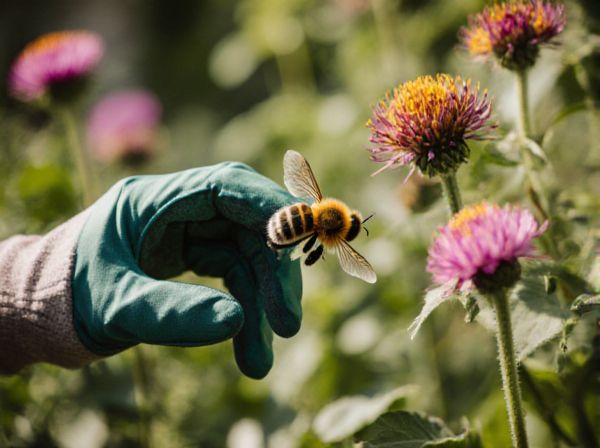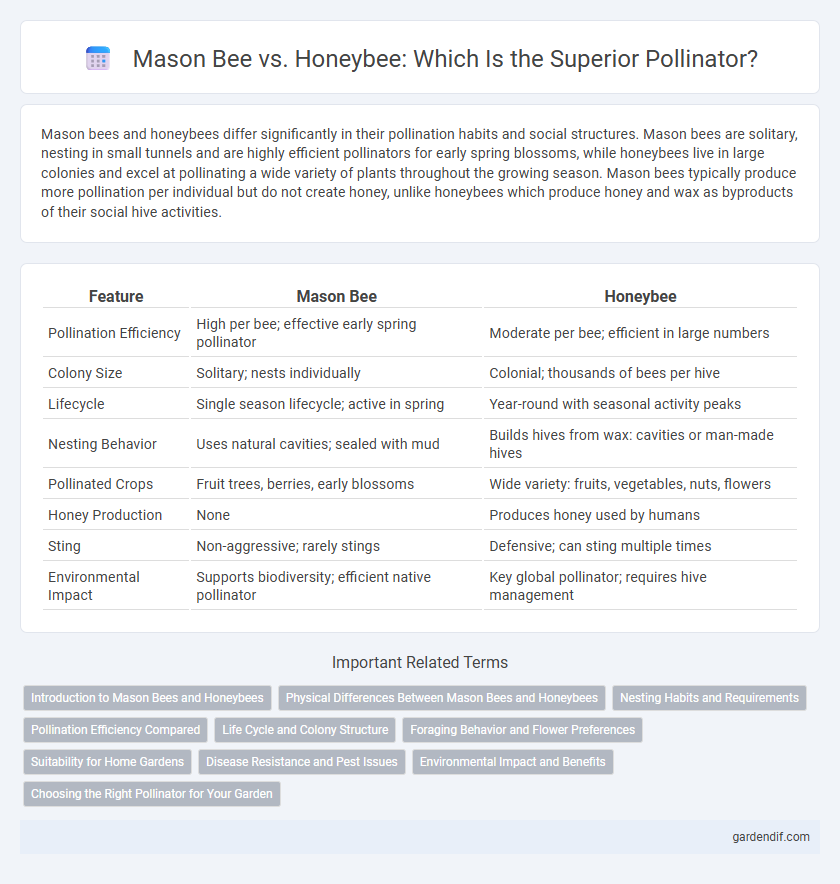
Mason bee vs Honeybee Illustration
Mason bees and honeybees differ significantly in their pollination habits and social structures. Mason bees are solitary, nesting in small tunnels and are highly efficient pollinators for early spring blossoms, while honeybees live in large colonies and excel at pollinating a wide variety of plants throughout the growing season. Mason bees typically produce more pollination per individual but do not create honey, unlike honeybees which produce honey and wax as byproducts of their social hive activities.
Table of Comparison
| Feature | Mason Bee | Honeybee |
|---|---|---|
| Pollination Efficiency | High per bee; effective early spring pollinator | Moderate per bee; efficient in large numbers |
| Colony Size | Solitary; nests individually | Colonial; thousands of bees per hive |
| Lifecycle | Single season lifecycle; active in spring | Year-round with seasonal activity peaks |
| Nesting Behavior | Uses natural cavities; sealed with mud | Builds hives from wax: cavities or man-made hives |
| Pollinated Crops | Fruit trees, berries, early blossoms | Wide variety: fruits, vegetables, nuts, flowers |
| Honey Production | None | Produces honey used by humans |
| Sting | Non-aggressive; rarely stings | Defensive; can sting multiple times |
| Environmental Impact | Supports biodiversity; efficient native pollinator | Key global pollinator; requires hive management |
Introduction to Mason Bees and Honeybees
Mason bees (Osmia spp.) are solitary pollinators known for their efficiency in pollinating early spring blossoms, especially fruit trees, by nesting in small cavities and using mud to create brood cells. Honeybees (Apis mellifera) are social insects forming large colonies with a single queen, producing honey while pollinating a wide variety of crops and wild plants. Both species play crucial roles in agriculture and ecosystems, with mason bees offering higher pollination rates per individual and honeybees supporting large-scale commercial pollination.
Physical Differences Between Mason Bees and Honeybees
Mason bees exhibit a more robust, metallic green or blue body with a fuzzy abdomen, while honeybees have a slender, golden-brown body with distinct black stripes and less hair. Mason bees possess stronger mandibles adapted for gathering mud to build nests, contrasting with honeybees' smoother mouthparts designed for nectar collection. The wings of honeybees are longer and more translucent compared to the shorter, more opaque wings of mason bees, reflecting their differing flight patterns and behaviors.
Nesting Habits and Requirements
Mason bees nest individually in small cavities such as hollow stems or holes in wood, using mud to partition their nests, requiring minimal maintenance and benefiting from diverse habitats. Honeybees form large colonies in hives, natural cavities, or man-made boxes, building wax combs for brood and food storage, needing more extensive space and resources. Mason bees prefer solitary nesting environments with access to mud and pollen, while honeybees thrive in social, structured hives with ample floral sources.
Pollination Efficiency Compared
Mason bees exhibit significantly higher pollination efficiency compared to honeybees, with studies showing they can pollinate up to 70% more fruit blossoms per visit. Their solitary nature reduces flower visitation overlap, resulting in more effective pollen transfer. Honeybees typically visit flowers more frequently but are less targeted, making mason bees superior pollinators for certain crops like almonds, apples, and blueberries.
Life Cycle and Colony Structure
Mason bees have a solitary life cycle, with females independently building and provisioning individual nest cells, while honeybees live in highly organized colonies consisting of a single queen, workers, and drones. Mason bee offspring develop in sealed brood cells within tunnels, emerging as adults in spring, contrasting with honeybee larvae that are continuously cared for by worker bees in a communal hive. This solitary nesting behavior of mason bees results in shorter generational cycles and less complex social structures than the perennial, cooperative honeybee colony.
Foraging Behavior and Flower Preferences
Mason bees exhibit solitary foraging behavior, visiting a diverse range of early-blooming flowers, which enhances cross-pollination efficiency in fruit orchards and wild plants. Honeybees are social foragers, primarily collecting nectar and pollen from a broader spectrum of floral sources, favoring abundant floral patches for sustained colony nutrition. The complementary foraging patterns of mason bees and honeybees contribute significantly to ecosystem pollination dynamics and agricultural crop yields.
Suitability for Home Gardens
Mason bees are highly suitable for home gardens due to their solitary nature and efficient pollination of early spring blossoms, requiring minimal care and no hives. Honeybees thrive in larger colonies and need more space and management, making them less ideal for small urban or suburban garden settings. Mason bees enhance fruit and vegetable yields with effective pollination, especially in limited garden areas where space and maintenance are concerns.
Disease Resistance and Pest Issues
Mason bees exhibit superior disease resistance compared to honeybees, primarily due to their solitary nesting habits, which reduce the risk of pathogen transmission. Honeybees often face significant challenges from pests such as Varroa mites and Nosema fungi, leading to colony declines and increased management efforts. The natural resilience of mason bees to pests and diseases makes them vital contributors to sustainable pollination strategies.
Environmental Impact and Benefits
Mason bees contribute significantly to biodiversity by pollinating native plants and requiring minimal resources, thereby reducing environmental strain compared to honeybees, which rely heavily on human management and large-scale hive maintenance. Honeybees, while efficient in commercial crop pollination, can spread diseases to wild pollinators and compete for resources, impacting local ecosystems. Mason bees enhance garden productivity with less environmental disruption, making them vital for sustainable pollination practices and preserving ecological balance.
Choosing the Right Pollinator for Your Garden
Mason bees (Osmia spp.) offer efficient early spring pollination for fruit trees, requiring minimal maintenance and posing no sting threat, making them ideal for home gardens focused on fruit production. Honeybees (Apis mellifera) excel in large-scale pollination with their extensive foraging range and honey production, but demand hive management and can be more aggressive. Selecting the right pollinator depends on garden size, crop type, and desired maintenance level, with mason bees favoring small-scale, high-efficiency pollination and honeybees supporting broader agricultural needs.
Mason bee vs Honeybee Infographic

 gardendif.com
gardendif.com